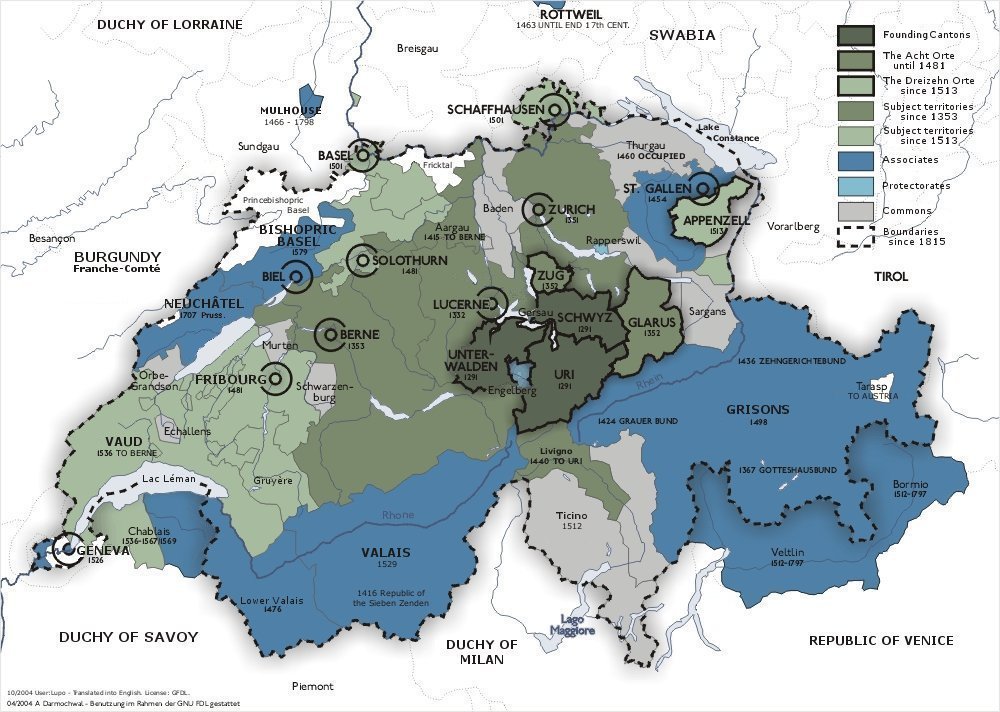Even though the legend of William Tell is more devoid of actual historical foundation than records of the period relate, it is more widely known and believed.
Continuing First Swiss Struggle for Liberty,
our selection from The Model Republic; a History of the Rise and Progress of the Swiss People by F. Grenfell Baker published in 1805. For works benefiting from the latest research see the “More information” section at the bottom of these pages. The selection is presented in five easy 5 minute installments.
Previously in First Swiss Struggle for Liberty.
Time: 1308
Place: Switzerland

CC BY-SA 3.0 image from Wikipedia
But, probably in consequence of his supposed connection with the legend of William Tell, the bailie to whom the name of Gessler has been given stands out more prominently in Swiss history than any other. Gessler’s residence, according to tradition, was a strongly fortified castle built in the valley of Uri, near Altorf, and this he named Zwing Uri (“Uri’s Restraint”). He used every means that cruelty or avarice could suggest in his conduct as governor, and incurred additional hatred from the methods he adopted to discover the members of a secret conspiracy he believed existed against him in the district. With this object in view, Gessler caused a pole, surmounted with the ducal cap of Austria, to be set up in the market-place at Altorf, before which emblem of authority he ordered every man to uncover and do reverence as he passed. The refusal of a peasant to obey this command, his arrest, trial, and condemnation to pierce with an arrow an apple placed on his own child’s head, his dexterity in performing this feat, his escape from his enemies, his murder of the tyrant Gessler, the solemn compact sworn at Ruetli, and the revolutionary events that followed form the motive of the much-celebrated legend of William Tell.
The mythical hero of this shadowy romance has long embodied in his person the virtues of the typical avenger of the wrongs of the poor and the oppressed against the tyranny of the rich and the powerful; his name has been honored and his manly deeds have been lauded in prose and verse by thousands in many lands for many centuries, exciting doubtless many a noble deed of self-denial, and spurring to the forefront many a popular act of patriotic daring. In Switzerland certainly this picturesque representative of liberty has done much to mould the political life, if not also to write many pages of the history of the people, and that in spite of the questionable morality of the received narrative of his career, and its unquestionable untruth. The emergence of the Swiss from slavery to freedom, as in the case of all other nations, was undoubtedly a gradual process, and there is now every reason for believing that the narrative relating to William Tell and the other heroes who are said to have been the prime instruments in the expulsion of the Austrian bailies from the districts of the Waldstaette are purely apocryphal, with a possible substratum of actual fact.
It is sad for an individual, and still more so for a nation, to lose the illusions of youth, if not of innocence, and to awake to the knowledge of an unbeautiful reality, bereft of all fictitious adornment. When, however, the naked truth can be discovered — and that is seldom the case — it must be faced; if the national or individual mind cannot receive it, the fault lies with the immaturity or morbid condition of the former, not with the material of the latter.
As the legend of William Tell is more devoid of actual historical foundation, and is more widely known and believed than are the many others related as the records of events happening at the period from which the Swiss date their independence, it may be as well to devote some little space to its consideration. All the local records that might possibly throw some light on the existence and career of Tell have now been thoroughly searched by many impartial and competent scholars, as well as by enthusiastic partisans, with the invariable result that, till a considerable lapse of years after the presumed date of their deaths, not one particle of evidence has been discovered tending to prove the identity of either William Tell or of the tyrant Gessler. On the other hand, many local authorities, as early as the beginning of the fifteenth and sixteenth centuries, when the story was fully established, have gone out of their way to deny its truth and prove its entire falsity from their own researches. Materials, indeed, are many relating to the events that befell the Waldstaette during their conflicts with the bailies, whom they succeeded in expelling from their country; and it seems in the highest degree improbable that, had Tell and his friends lived and taken so prominent a part in effecting their country’s freedom as is popularly assigned to them, they should have been entirely ignored by all contemporary writers, as well as by subsequent ones, for a hundred and fifty or two hundred years — yet such is the case.
| <—Previous | Master List | Next—> |
More information here and here, and below.
 |
We want to take this site to the next level but we need money to do that. Please contribute directly by signing up at https://www.patreon.com/history
Leave a Reply
You must be logged in to post a comment.